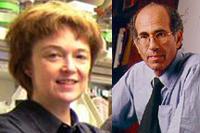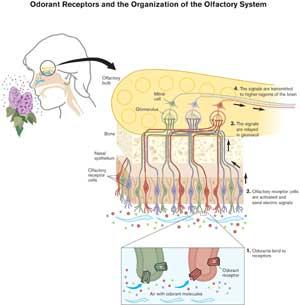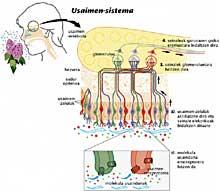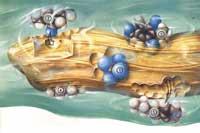Medical novel by illuminating the path in the labyrinth of smell
2004/10/04 Galarraga Aiestaran, Ana - Elhuyar Zientzia

Despite previous studies on smell, they still did not know how men separate and evoke 10,000 smells. Axel and Buck have worked on it and have seen that a family of genes from around a thousand genes encodes as many types of olfactory receptors. In addition, they have found that the cells that contain these receptors are at the top of the nasal epithelium and that they are the ones that detect inhaled odorous molecules.
Each olfactory cell has a single type of odor receptor and each receptor can only detect certain odorous substances. Therefore, olfactory cells are specific for a few odors. Once the smell is detected, the nerve signals are sent to specific, glomerular microzones. These glomerules are found in the olfactory bulb of the brain, the olfactory bulb being the main nucleus associated with smell.
From glomeruli, information is extracted to other places in the brain, where information from different olfactory receptors is collected and a model is generated. This allows us to remember the smell of a flower flavored in spring at any other time.
Each smell, its pattern
Knowing what the mechanism of the olfactory system is is the cost of many years of work. Richard Axel and Linda Buck jointly published in their basic research the family of genes encoding olfactory receptors. Year 1991. Since then, each has worked on his own in parallel investigations and have solved several mysteries of smell, both at the molecular level and in the cellular organization.
The olfactory system is the first sense illuminated by molecular techniques. These techniques have shown that each olfactory receptor activated by an olorous molecule activates a G protein in the brain. So protein G makes the messenger molecule cAMP, which opens the ion channels of brain cells. Therefore, the cell is activated.
Olfactory receptors are proteins, all similar, but with details that differentiate them. This explains why some with odorous molecules and others with others. Each receptor is formed by a chain of amino acids that consists of seven ‘stitches’ to the cell membrane. In this way, it forms a pocket in which the olorous molecule enters. When this happens, the aspect of the receptor changes, so G protein is activated.
Separately
Axel and Buck, separately, have shown that each olfactory cell expresses a single gene, so there are as many types of olfactory cells as olfactory receptors. This discovery was surprising, as they did not expect it. On the other hand, by recording the electrical signal of these cells it has been proven that each cell is activated with more than one olorous molecule, but that the intensity varies according to the molecule.
Activation of brain glomeruli has been studied separately, but the results are complementary. Research has found that the information that reaches the glomeruli is combined and that this combination creates a model. An odor is a combination of several odorous molecules, each of which activates several receptors. The odor model is generated by adding the information sent by them, and each odor has its own smell. The human being is able to recognize and remember about 10,000 smells.
Moreover, in some animals pheromones are essential for the different functions of life, such as sexual reproduction. These two Nobel laureate researchers have also paid attention to pheromones and have shown that the system they form closely resembles the olfactory system in many respects.
Other articles on the olfactory system:
What feelings! One thousand perfumes

Gai honi buruzko eduki gehiago
Elhuyarrek garatutako teknologia







